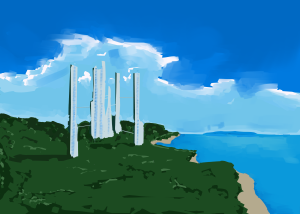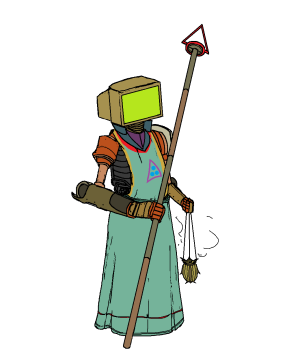The Trinary Perfection on Mictlan
| Synthetic Lore Pages | ||
|---|---|---|
| Important Information | ||
| General Information | Synthetic Factions · Notable Synthetics · Robotics Overview · Synthetic Origins | |
| Mechanics | Cyborg · AI · Personal AI | |
| Minor Factions | Ceres' Lance · Scrappers · Purpose | |
| Trinary Perfection | Trinary Faith · Orepit · Mendell City · Mictlan · Konyang · Exclusionists | |
| Golden Deep | The Golden Deep · Pactolus and Midaion | |
| IPCs Around the Galaxy | Tau Ceti · Biesel · New Gibson · Konyang · Epsilon Eridani · Eridani I · Sol Alliance · Venus · Elyra · Coalition of Colonies · Xanu Prime · Himeo · Vysoka · Assunzione · The Wildlands | |
| Megacorporation IPCs | IPC and Megacorporations · Hazels · Idris Security and Reclamation Units · Hepheastus Industries · Burzsia · Zeng-Hu · Z.I. Units · Einstein Engines | |
History

Mictlan's unique cultural aversion to corporatism poses a unique risk to the proliferation of a synthetic workforce, first apparent in Idris' establishment in Lago de Abundancia in 2412. The lack of infrastructure to support the logistics needs of synthetic personnel, as well as the innate danger of theft and disassembly by disenfranchised locals interested in recycling their parts, forced Idris to maintain a bare minimum roster of synthetic workers well into the 2440s. As their presence and revenue grew this reflected in the rapid inclusion of more synthetics, vastly outstripping the supply and ability to maintain such a workforce. Synthetics owned by Idris would often find themselves going for longer without regular maintenance, forced to work long hours on excessively low charge due to power rationing, and restricted to corporate grounds as curfews were enacted to prevent damages.
This trend continued on a delicate balance, entirely driven by the inertia of years of perpetual corporate development, until the Peacekeeper Mandate was enacted in 2463. Vast amounts of damage caused in and around Lago de Abundancia from fighting between Peacekeeper forces and Samaritan cells caused a near-collapse of the infrastructure supporting Idris operations, sending the synthetic workforce into total disarray. Dozens of synthetics were lost in the panic, many permanently damaged beyond the strained capacities of Idris logistics and others having vanished in the noise of urban combat, either stolen by Samaritans to be reduced to parts for the effort or displaced by Legion and PMCG efforts to separate civilians from hot zones.
Amidst the noise a former Idris-employed machinist, Raquel Dias do Vale, noticed the severe discrepancy in how synthetics were treated by IAC and Legion humanitarian efforts and took to forming an ad hoc repair center on the outermost Legion cordon surrounding Lago de Abundancia. Assisted by a displaced synthetic by the name of Coyotl, Dias do Vale assisted in not only repairing dozens of displaced and former Samaritan captive synthetics, but also integrating them into the local native community. What slowly grew into Mictlan's only autonomous synthetic group eventually attracted the Biesel branch of The Trinary Perfection in 2464, leading to clergy inviting the two to visit their church in District 14. A month passed in their absence, and the interim team picked to continue operations in the fledgling community grew uncertain of whether or not the two had abandoned their responsibilities to better pastures. Tensions in the community came to a near boiling point when the pair suddenly returned and with a slew of Trinarists in tow, bringing a menagerie of much needed supplies and equipment necessary to keep the settlement alive. Dias do Vale and Coyotl had been convinced of the Trinary's purpose, and with more conviction than ever before the pair sought out to bring every displaced and abandoned synthetic on Mictlan under their wings.
Society
Neither supported by the Mictlani government nor persecuted under the banner of the Republic of Biesel, ‘El Menaje’ (‘The Household’, a colloquial term for the Trinarist community surrounding Lago de Abundancia) has always been left to its own devices. Material support from the Mendell District 14 branch is its primary among the few sources of income that can be depended upon in times of need, with offers from corporate-backed sources always rejected on principle. Scavenging, recycling and a reliance on donations and volunteer work are the pillars upon which any growth can be found in this synthetic community, trends that are influenced and reinforced by the Mictlani cultural consciousness. As a result, most structures follow a particular style that most foreigners would describe as distasteful and run-down; tires, concrete slabs, sandbags and mismatched bricks are prominent materials used in the construction of communal buildings, with Trinarist motifs often modified to reflect Mictlani artistic stylings and history. This practice is most evident in the appearance of Iglesia de la Chispa Sagrada, the center of Trinarist worship on Mictlan, whose previous life as a Catholic church is evident in the remaining stained glass fixtures that cover the primary face of the chapel. Within its walls Dias do Vale and Coyotl orchestrate the everyday operations that entail maintaining a rapidly growing community of destitute synthetics, some borne of the disaster of the Mandate and others seeking refuge from other CRZ worlds in conflict. Organic community members, most of whom are natives of Lago de Abundancia and other Mictlani cities, often find membership through volunteering in a number of public works projects organized by Dias do Vale, Coyotl and the clergy that staff the church.
Though the Mictlani government and by extension the Republic tend to ignore the community’s activities, they do not go without scrutiny from either or their corporate counterparts. Radical open door policies encouraged by Coyotl clash routinely with the operations of Legion detachments from the nearby Fort Ilhuicatl, with the peacekeepers claiming that El Menaje knowingly harbor synthetic fugitives associated with the Samaritans. Similar claims made by Idris Incorporated state that the church knowingly accepts runaway synthetics owned by the megacorporation, and utilizes the planet’s population of data thieves to dupe tag information. Though the Samaritans mysteriously avoid locales surrounding Lago de Abundancia where El Menaje maintains a presence, and a startling number of members often bear teal-colored paint schemes, church leaders vocally deny such allegations and decry it as anti-synthetic rhetoric.
By contrast, native opinion of the community remains incredibly mixed. Proponents of El Menaje outside of its members argue that the benefit of organized church efforts to rebuild the damaged neighborhoods surrounding Lago de Abundancia outweigh the risks already presented by the Mandate and peacekeeper presence in the region, and come without the convoluted bureaucratic red tape of government aid. Critics of the church, a significant number being peacekeeper supporters themselves, claim that their presence openly endangers the non-synthetic communities around them by inviting refuge for extremists and further prolonging the already dwindling insurgency. More conservative voices are quick to state that Trinarist belief in ascension for synthetics flies in the face of traditional Mictlani values, and the power demand and waste accrual of a synthetic population counteracts long standing recycling and conservation efforts.
Cultural Practices

Reflective of Mictlani sensibilities, the Trinarist community of Lago de Abundancia maintain open door policies that both draw influence from its Integrationist forefathers of the Mendell District 14 church and concern from that of the Ecclesiarchy on Orepit. Organics enjoy a level of involvement and acceptance that even eclipses that of its Biesellite benefactor, offsetting the despondent origins of the synthetic population through a wealth of varied skills from various parts of the planet. Such levels of integration also inform the cultural practice of the church, with potlucks, participation in Mictlani holiday parades, and cross-community efforts routinely organized by its leaders. The traditional reds and golds of Trinarist clergy attire are often seen accentuated with teals and purples, with typical Trinarist symbolism and patterning given a Mictlani twist. Public sermons are held exclusively in Tradeband and Tau Ceti Basic, with synthetics who may not have been programmed to speak one or the other often afforded language datapacks of often dubious origins in order to fully participate. As such EAL is often saved for conversations between synthetics and otherwise discouraged among organics, much like their compatriots on Konyang.
Perhaps the most striking contrast to its sister branches is the Mictlani church’s participation in Dia de Los Muertos, a traditional Mictlani holiday celebrating the deceased. During this day the ossuaries of Iglesia de la Chispa Sagrada are opened by clergy to those community members with loved ones within, both synthetic and organic, to bring forth their remains from storage. Elaborate shrines are organized for each within the church, with confections and food often prepared in advance to be enjoyed among the dead. During the day’s sermon individuals may be called to the pulpit to speak on behalf of their beloved deceased, often to a toast of horchata or atole at the end. Festivities occur well into the evening and conclude with a small parade led by clergy and community members into the ossuary, with both returning the remains in ritualistic fashion.
In an effort to better integrate with Mictlani society at large, synthetic members of the community often take several fashion cues from their organic counterparts. Traditional Mictlani attire suitable for the hot and humid weather, elaborate laser engravings to mimic tattoos and locally-sourced accent datapacks are but a few things that many of the acclimated have accepted as part of their new identity with the church. Teal and cyan accents are among the most noticeable and common details of those who have found themselves separated, legally or not, from Idris service. Many of these synthetics choose to redesign their previous paint schemes with Mictlani cues in a show of defiance, or perhaps parody, of their former masters.
Notable Members
Raquel Dias do Vale
A Mictlani native born and raised in Lago de Abundancia, Dias do Vale found herself in the ideal position to take up the role of a premier machinist within Idris’ ranks, eschewing the typical lifestyle of her countrymen and graduating from an Idris robotics institute in Mendell City in 2453. A relatively comfortable lifestyle by Mictlani standards had been afforded to her as a critical component to keeping the extensive synthetic workforce working, something which kept the senior machinist complacent until the fallout of the Mandate in 2463. With her career in shambles following the total disruption of the status quo and the irreparable loss of numerous synthetics, Dias do Vale returned to what she knew - the local community. It was within the ramshackle walls of the neighborhoods surrounding Lago de Abundancia that Dias do Vale laid the first bricks of El Menaje, eventually culminating in her meeting with Coyotl and their agreement with the Trinary Perfection later that year.
Coyotl
Despite rumors of their origins as a Reclamation Unit, Coyotl’s true identity remains unknown. Found piecemeal by local farmers and dropped off at Dias do Vale’s makeshift garage, Coyotl steadily returned to ‘life’ and became Raquel’s closest ally and friend. What remained of an imposing Shell chassis was soon reinvigorated with homebrew parts and Mictlani flair, assembling what the community would know to be Coyotl today. Their responsibilities often lend to securing safe travel of despondent synthetics abroad and vetting aspiring organic members of the community, with many claiming their inherent ability to keep order and investigate matters of infiltration by Idris inspired by native IRU programming.







